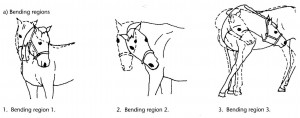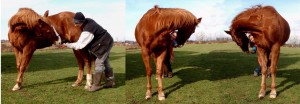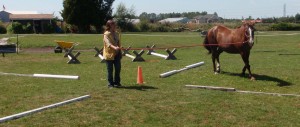Work on the Lunge Line – Part 15
|
|
Arbeit an der Longe – Teil 15
|
Gymnastic exercises:
- We saw in the last Blog (point 7) that a horse balancing himself on a curved line at liberty turns by stretching his neck to the outside and leaning into the turn, whereby the hind quarters swing to the outside.
- The reason we wish to change this is because we want to change the horse into a weight-carrying animal: we established that a horse (since in nature he never carries anything) must learn from us the kind of balance, where he remains upright on the circle, bending his neck and ribcage while stepping under his gravity point with his hind legs, as required for riding or vaulting.
- If we try to teach him this by pulling his head to the inside via side-reins, then he will push into the circle and the hind end swerves out even more. The horse does not bend this way and learns nothing! We therefore play games to teach him balance without coercion and drive his shoulders out, so that they line up with the hind quarters again and the lunge line remains taut. We attach our running reins only once the horse starts to find his balance on a curved line himself (through our games), so he will never feel them as pressure, but as help. Only then can we achieve soft contact and a correct bend.
- In the end we want to achieve that the horse improves his impulsion and seeks contact to the bit through stretching his top line.
- Stretching is the first step. It is a very good idea to limber up your horse’s neck and spine before you demand a relaxed bend on the lunge line. Any other athlete warms up with stretching! Check out the “Mobilisation” games in “From Leading to Liberty” (pages 105 to 121), which we also recommend before each riding session!
click on picture to enlarge |
|
Gymnastizierung:
- Wir haben im letzten Blog gesehen, daß ein Pferd sich auf einer gebogenen Linie ausbalanciert, indem es seinen Hals nach außen streckt und sich in die Kurve lehnt, wobei die Hinterhand ausschert.
- Wir wollen dies ändern, weil wir das Pferd in ein gewicht-tragendes Tier verwandeln: wir haben schon bemerkt, daß ein Pferd, welches ja in der Natur nie etwas trägt, es von uns lernen muß sich so ins Gleichgewicht zu stellen, daß es auf dem Zirkel aufrecht bleibt und seinen Hals und Körper biegt, während es mit seinen Hinterbeinen unter seinen Schwerpunkt tritt – denn das ist es, was wir zum Reiten und die Voltige brauchen.
- Wenn wir versuchen ihm das beizubringen, indem wir seinen Kopf mit Ausbindern nach innen ziehen, dann wird es noch mehr nach innen drängen und die Hinterhand noch mehr nach außen scheren. So biegt sich das Pferd nicht und lernt nichts! Daher lehren wir es diese neue Balance ohne Zwang wieder spielerisch und treiben seine Schultern hinaus, so daß sie sich wieder auf die Hinterhand ausrichten und die Longe ansteht. Die Hilfszügel verschnallen wir erst, wenn das Pferd alleine die Balance so (durch unsere Spiele) auf dem Zirkel gefunden hat, so daß es sie nie als Zwang empfindet, sondern als Hilfe. Nur so können wir einen sanften Kontakt und korrekte Biegung erreichen.
- Als Endergebnis wollen wir verbesserten Schwung und Kontakt über das Gebiß erreichen, wobei das Pferd seine Oberlinie strecken soll.
- Stretching ist der erste Schritt. Es ist eine gute Idee die Wirbelsäule Ihres Pferdes zu mobilisieren, bevor Sie eine relaxierte Biegung auf dem Zirkel verlangen. Alle Athleten wärmen sich mit Stretching auf! Lesen Sie die “Mobilisation” Spiele im Buch “From Leading to Liberty” (Seiten 105 bis 121), die wir auch vor jeder Reitstunde empfehlen!
- klicken Sie auf das Bild zum Vergrößern
|
 We mobilise the entire spine from poll to croup.
Wir mobilisieren die ganze Wirbelsäule vom Genick bis zur Kruppe.
|
- To have real gymnastic value for the horse these exercises must be much more than just luring your horse about with a carrot! They range from bowing, bending, rocking to crossing legs, and are only truly healthy for your horse, if you guide him correctly through the regions of each stretch.
|
|
- Damit diese Übungen einen realen gymnastischen Wert für das Pferd haben müssen sie mehr sein als nur ein Herum-Gelocke mit einer Möhre! Es geht über Beugen, Biegen und Wiegen zum Übertreten – all dies nur wirklich gesund, wenn Sie dabei
Ihr Pferd korrekt durch die einzelnen Regionen des Stretches führen.
|
 It is important to guide the horse throught the regions correctly.
Man muss die Regionen korrekt durchlaufen. |
- Even though you might hear significant cracks as blockages are released, you can’t do damage to your horse as long as you pass from one region of a stretch to the next by guiding him in such a way that he follows your hand voluntarily. So please take time to study how to guide him correctly, so that the interstices of the vertebrae of his neck and spine get opened one by one in a healthy manner, the path of the nerves is freed and possible blockages are released. If these stretches do not relax the horse you are doing them incorrectly – back to the book! Male horses will generally show their utter relaxation by dropping their penis and all horses will sigh contentedly.
|
|
- Obwohl man manchmal laute Knackse hört, wenn sich Blockaden lösen, kann man hierbei seinem Pferd keinen Schaden antun, solange man es so führt, daß es freiwillig der Hand folgt. Bitte investieren Sie die Zeit zu lernen, wie man es so anleitet, daß sie die Wirbel nach einander in gesunder Weise öffnen, damit sich Blockaden lösen können. Wenn diese Übungen Ihr Pferd nicht entspannen, machen Sie etwas falsch – zurück zum Buch! Männliche Pferde schachten hierbei generell aus und alle seufzen zufrieden.
|
 With training any healthy horse can reach his knee!
Mit ein bisschen Training kann jedes gesunde Pferd sein Knie erreichen!
|
- After these stretches, and back on the lunge line, we teach him stretching of the top line by continuous changes in direction, mainly by switching from curved to straight lines. During the schooling the lunger therefore must move a lot! Staying in one spot with the your heel anchored to the centre of the earth is good for a vaulting performance, but not for schooling the horse!
- For these first exercises I would still prefer to hook the lunge line into the centre ring of the cavesson. We presume now your horse is calm enough to keep the lunge taut without you having to pull on the horse, as otherwise he might kink his head.
- If he is calm you can now attach the running reins to the bridle, they give the horse a frame to work within, but retaining freedom of movement with his neck and head.
- We will now practise to switch from curved to straight lines frequently to gymnasticise the horse’s muscles. Your whip must give exactly the right information at the moment the horse needs it: it changes position from framing the horse on the circle to pointing him out (toward his shoulder) the exact moment, when we want him to switch to the straight line. I also stretch my lunge-arm at that moment (on the circle the upper arm hangs vertical and relaxed as in riding) and point with my index finger. Check the pattern illustration in next week’s Blog for further information.
- In order to not make the horse insecure through your own movement and to not disturb him in the mouth you must become well coordinated with your legs, hands and general body language. Turn your eyes and shoulders in the direction of travel, when you march off! You give a little on the lunge line when you change to the straight line, perhaps step more toward his croup to egg him on, and give a half halt when switching to a circle again. (Yes, even on the cavesson!).Remember that “Who moves Whom” is an ever important rule for authority in the horse’s world! If you stand still for too long your horse’s attention will vane…
- Review the game Lunging maze on page 169 of the book. Try to achieve a calm and regular gait throughout, first in walk, then in trot. The horse should neither speed up in the corners (a sign of imbalance and insecurity) nor on the straight lines (you are driving him too much, put yourself a bit more to the front relative to the horse).
|
|
- Nach dieses Stretches und wieder an der Longe lehren wir das Pferd ein Dehnen der Oberlinie durch ständige Richtungswechsel , hauptsächlich durch Wechsel von gebogenen zu geraden Linien. Der Longenführer muß daher beim Training viel laufen! Das an der Stelle bleiben (mit Ferse fest verankert) ist richtig für eine Voltigevorführung, aber nicht um das Pferd auszubilden!
- Für diese ersten Übungen möchte ich immer noch die Longe im mitlleren Ring des Kappzaums verschnallt sehen. Wir nehmen nun an, daß Ihr Pferd ruhig genug ist die Longe straff zu halten, ohne daß Sie ziehen müssen, sonst verwirft sich das Pferd im Genick. Wenn das Pferd ruhig ist können Sie nun die Hilfszügel an der Trense befestigen, um es seitlich zu begrenzen, ohne jedoch seine Beweglichkeit mit Hals und Kopf zu beschränken.
- Jetzt wollen wir den häufigen Wechsel von geraden zu gebogenen Linien üben. Ihre Peitsche muß die richtige Information in genau dem richtigen Moment vermitteln: sie wird vorn oder hinten eingesetzt – vom Einrahmen der Hinterhand zum Hinausweisen (zur Schulter), wenn das Pferd zur geraden Linie wechselt. Ich strecke in dem Moment auch den Longenarm aus (auf dem Zirkel hängt der Oberarm wie beim Reiten entspannt senkrecht) und deute mit dem Zeigefinger. Beachten Sie die Illustrationen im Blog nächste Woche!
- Um das Pferd durch Ihre Bewegungen nicht zu verunsichern und es nicht im Maul zu stören, müssen Sie mit Ihren BeinenHänden und generell der Körpersprache ziemlich koordiniert werden. Drehen Sie Augen und Schultern in Bewegungsrichtung, verschieben Sie Ihre Position mehr in Richtung Kruppe um zu treiben, und geben Sie eine halbe Parade, wenn Sie wieder zum Kreis wechseln. (Auch am Kappzaum!)Vergessen Sie nie, daß das “Wer bewegt Wen” eine wichtige Regel für Authorität im Herdenleben ist! Wenn Sie zu lange still stehen,verpufft die Aufmerksamkeit Ihres Pferdes vielleicht…
- Spielen Sie noch einmal das “Longenlabyrinth” auf Seite 169 des Buches. Versuchen Sie eine ruhige und regelmäßige Gangart zu erreichen, erst im Schritt, dann Trab. Das Pferd sollte weder in den Ecken schneller werden (ein Zeichen von Balanceverlust oder Unsicherheit) noch auf den geraden Linien (vielleicht treiben Sie zu viel – treten Sie relativ zum Pferd ein bißchen mehr nach vorn).
|
 The horse bends naturally and without coercion. In the “Labyrinth” he is very attentive!
Das Pferd biegt sich natürlich und ohne Zwang. Im “Labyrinth” bleibt es immer aufmerksam! |
- Convex versus concave side of the horse:
- Philippe Karl always stresses the differences of work on the “hollow” and the convex side of the horse. If your horse is hollow to the left (as most horses are):
- On the right hand – he will push more to the inside of the circle
on the right hand. You should keep the circle large and very often go straight in active tempo.
|
|
- Hohle und konvexe Seite des Pferdes:
- Philippe Karl betont immer die Unterschiede der Arbeit auf der hohlen oder konvexen Seite des Pferdes. Wenn es von Natur aus links hohl ist (wie die meisten es sind):dann wird es auf der rechten Hand auf dem Zirkel vermehrt nach innen drängen. Legen Sie den Kreis groß an und wechseln Sie oft zu geraden Linien in flottem Tempo.
|
 If your horse is hollow on the right, the opposite applies.
Wenn Ihr Pferd rechts hohl ist, gilt das Gegenteil. |
- On the left hand – he will easily bend his neck to the left, but drifts over his outside shoulder. Therefore you use the wall or fence as “containment” and slow down the tempo. (If your horse is hollow to the right, the opposite will apply) This way we get closer to a symmetry of right and left – the necessary prerequisite for a straight horse.
- During all of this you watch for looseness and calmness of the horse. You want to see even, rhythmic motion, a loosely swinging tail and a relaxed neck. If your horse gets nervous in trot, go back to walk. Always make everything easier, if your request is not fulfilled in a relaxed manner – you asked too much! Give him time: keep phases short, demand little, praise often! Make each tiny little improvement an opportunity for a celebration – then you are a good motivator! Never forget to shout “good boy (or girl)” the very moment, something worked just a little better than last time! Then stop and praise – feed your treat and pet him, until you hear that content sigh – the only sign, which assures you that now even your horse’s soul relaxed and is happy.
- Make sure you are fair by being fully concentrated while you work. (You did turn that phone off, didn’t you?) If you get confused, get organised while giving your horse a break – breaks are always welcome. Check that your own body language is accurate and clear to your horse at all times – handling lunge and whip calmly and applying the signals (mentioned earlier) correctly – always with a prompt verbal praise, if understood and followed. Keep an even tempo and keep the lunge slightly taut at all times.All this sounds easier than it is, so give yourself a lot of time to practise it. But don’t bore your horse to death by only lunging him from now on! Variety is the spice of life and 20 minutes twice or three times a week is enough. Always stop on a high note (even if the 20 minutes are not up yet)!
Next time more patterns, more games! |
|
- Auf der linken Hand dagegen wird es zwar seinen Hals leicht nach innen biegen, aber über die äußere Schulter ausfallen. Daher nutzen Sie eine Wand oder Zaun als Begrenzung und vermindern das Tempo. (Wenn Ihr Pferd rechts hohl ist gilt das Gegenteil). So erreicht man eine Symmetrie zwischen links und rechts – die nötige Voraussetzung, um das Pferd gerade zu richten.
- Immer beachten Sie, daß Ihr Pferd entspannt und losgelassen bleibt. Sie wollen einen sauberen Rhythmus, einen schwingenden Schweif und fallengelassenen Hals sehen. Wenn Ihr Pferd im Trab nervös wird, verlangen Sie wieder Schritt. Machen Sie die Anforderung immer wieder einfacher, wenn es nicht entspannt klappt! Dann habe Sie zu viel verlangt. Halten Sie die Reprisen kurz, verlangen Sie wenig, loben Sie oft! Feiern Sie jede kleinste Verbesserung – dann sind Sie ein guter “Motivator”! Vergessen Sie nie “guut!” zu rufen, und zwar genau in dem Moment in dem es gerade ein bißchen besser als letztes Mal funktioniert hat! Dann Stopp – füttern und streicheln, bis man das zufriedene Seufzen hört, das zeigt, daß nun auch die Seele Ihres Pferdes entspannt und happy ist.
- Sie werden sich bei der Arbeit aus Fairness immer voll konzentrieren. (Sie haben ja Ihr Handy abgestellt, nicht wahr?) Wenn Sie konfus werden, machen Sie eine Pause zum Nachdenken – Pausen sind immer gut. Versichern Sie sich, daß Ihre Körpersprache akkurat und dem Pferd jederzeit klar ist – und daß Sie die Longen- und Peitschensignale (wie früher erwähnt) korrekt anwenden – immer mit promptem Stimmlob, wenn sie verstanden und befolgt wurden. Beachten Sie ein gleichmäßiges Tempo und halten Sie die Longe immer leicht gestrafft.All dies klingt einfacher als es ist, also geben sie sich auch genug Zeit es zu üben. Aber langweilen Sie nun nicht Ihr Pferd zu Tode, indem Sie immer nur longieren! Abwechselung ist das halbe Leben und 20 Minuten zwei- oder dreimal die Woche ist genug. Hören Sie immer bei der besten Leistung auf (selbst wenn die 20 Minuten noch nicht um sind) !
- Nächstes Mal: mehr Muster und Spiele!
|






